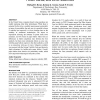Free Online Productivity Tools
i2Speak
i2Symbol
i2OCR
iTex2Img
iWeb2Print
iWeb2Shot
i2Type
iPdf2Split
iPdf2Merge
i2Bopomofo
i2Arabic
i2Style
i2Image
i2PDF
iLatex2Rtf
Sci2ools
CHI
2007
ACM
2007
ACM
Usability of voting systems: baseline data for paper, punch cards, and lever machines
In the United States, computer-based voting machines are rapidly replacing other older technologies. While there is potential for this to be a usability improvement, particularly in terms of accessibility, the only way it is possible to know if usability has improved is to have baseline data on the usability of traditional technologies. We report an experiment assessing the usability of punch cards, lever machines, and two forms of paper ballot. There were no differences in ballot completion time between the four methods, but there were substantial effects on error rate, with the paper ballots superior to the other methods as well as an interaction with age of voters. Subjective usability was assessed with the System Usability Scale and showed a slight advantage for bubble-style paper ballots. Overall, paper ballots were found to be particularly usable, which raises important technological and policy issues. Author Keywords Voting, effectiveness, efficiency, subjective usability, DRE....
CHI 2007 | Human Computer Interaction | Paper Ballots | Subjective Usability | System Usability Scale |
| Added | 30 Nov 2009 |
| Updated | 30 Nov 2009 |
| Type | Conference |
| Year | 2007 |
| Where | CHI |
| Authors | Michael D. Byrne, Kristen K. Greene, Sarah P. Everett |
Comments (0)

